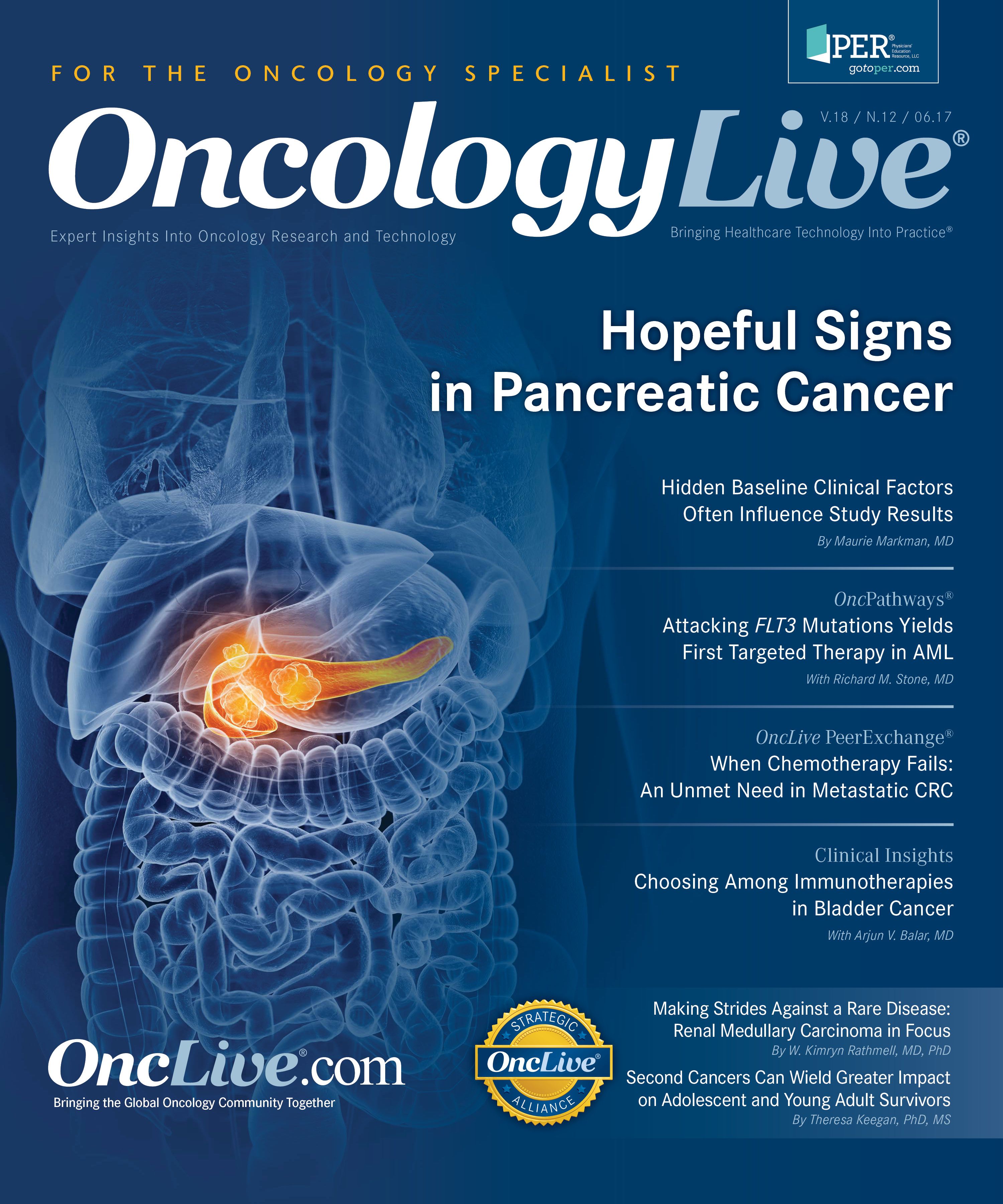Hidden Baseline Clinical Factors Often Influence Study Results
There is an intense and seemingly growing debate within the clinical, research, and regulatory arenas regarding what should be appropriately required to declare that a new or novel strategy be considered an acceptable standard-of-care approach to cancer management within a particular setting.
Maurie Markman, MD

Maurie Markman, MD
There is an intense and seemingly growing debate within the clinical, research, and regulatory arenas regarding what should be appropriately required to declare that a new or novel strategy be considered an acceptable standard-of-care approach to cancer management within a particular setting. Traditionally, phase III randomized trials with overall survival, or more recently progression-free survival, have been the gold standards in this arena. However, due to the definition of progressively smaller patient subgroups for which a targeted therapeutic appears to be clinically relevant, the time, effort, and cost associated with the conduct of such studies is increasingly problematic. As a result, it is essential that alternative study designs continue to be developed and examined for clinical utility.
Although these questions have been widely discussed in clinical research circles, there is another important issue associated with the appropriate interpretation of randomized trials that unfortunately has not received adequate attention. That is the heterogeneity of relevant clinical features among participants in such studies that, in the past, would have been considered to be far more homogeneous. The concern is that this phenomenon has an impact on study outcomes independent of the specific question being addressed in the particular study.
Examples Mount
Specifically, great care is routinely taken in comparative trials to prevent imbalances in what are suspected, or known to be, clinically relevant baseline factors that might influence survival, such as age, sex, tumor stage, or the number of prior treatment regimens. However, the concern is that there are additional clinical factors previously unknown to directly influence therapeutic outcomes that are potentially relevant and that imbalances of these features might interfere with the evaluation of an investigative strategy.A striking example of such a development was the outcome of a randomized phase II trial comparing a PARP inhibitor, olaparib, with single-agent pegylated liposomal doxorubicin (PEG) in the treatment of BRCA mutation—positive recurrent epithelial ovarian cancer.1 At the time of initiation of this trial, PEG had well-known activity in this clinical setting, having been FDA approved years earlier as a single agent in second-line or later treatment of the malignancy. Similarly, single-agent phase II clinical trial data had provided strong evidence for the clinical activity of olaparib against ovarian cancers in the presence of a germline BRCA mutation. However, in the absence of data to the contrary, it was assumed that PEG would possess activity in tumors with a germline BRCA mutation similar to that observed in multiple clinical trials in patients unselected for mutation status.
The randomized study failed to reveal any difference in activity between PEG and olaparib, initially suggesting relatively limited utility for the PARP inhibitor in this setting. However, when the outcomes of the PEG-treated patients were more carefully analyzed, it became clear the study results were in fact not due to the lack of activity for the PARP inhibitor, but rather there was a surprising level of activity for PEG in the presence of a germline BRCA mutation. Further, these data raise the critical question of the clinical activity of other antineoplastic agents in BRCA mutation— positive ovarian cancer (versus BRCA wild-type) and suggest knowledge of BRCA status is highly relevant as an additional stratification factor in all drug therapy trials in this malignancy.
Another example of the relevance of a baseline clinical factor that may influence clinical outcomes is the documented presence or absence of direct peritoneal cavity involvement in metastatic colon cancer.2 In a recently reported analysis of 14 phase III randomized trials conducted between 1997 and 2008, 13% of 10,553 patients exhibited evidence of peritoneal cavity involvement with the cancer. The finding of peritoneal metastasis and ≥1 other site of metastasis was associated with a statistically significant inferior overall survival compared with individuals with isolated non—peritoneal cavity metastatic disease (median 12.6 vs 20.0 months; HR, 1.79; P <.0001). In fact, based on these impressive data, it would be reasonable to conclude that any future comparative examination of the utility of a novel antineoplastic agent in colon cancer should ensure the absence of imbalances in the proportion of individuals with peritoneal cavity involvement between the study arms.
A final example of the impact of background clinical features on the results of an antineoplastic therapeutic comes from the experience with sorafenib in the management of hepatocellular carcinoma.3 In a meta-analysis of 3 phase III trials that examined the utility of this agent versus an alternative drug, there was strong evidence for the utility of sorafenib in patients with hepatitis C as the etiologic agent in the disease process (median survival, 12.6 versus 10.2 months) but, unfortunately, no evidence of clinical benefit in individuals whose disease resulted from hepatitis B infection. These data support the hypothesis that future trials of novel agents in hepatocellular carcinoma need to consider the etiology of the disease process within the stratification factors in addition to other established clinical features.
These examples highlight increasingly recognized concerns about attempting to isolate the influence of a single relevant factor in cancer trials and, in fact, suggest a reason for challenging claims that an individual study has accomplished this goal.
References
- Kaye SB, Lubinski J, Matulonis U, et al. Phase II, open-label, randomized, multicenter study comparing the efficacy and safety of olaparib, a poly (ADP-robose) polymerase inhibitor, and pegylated liposomal doxorubicin in patients with BRCA1 or BRCA2 mutations and recurrent ovarian cancer. J Clin Oncol. 2012;30(4):372- 379. doi: 10.1200/JCO.2011.36.9215.
- Franko J, Shi Q, Meyers JP, et al. Prognosis of patients with peritoneal metastatic colorectal cancer given systemic therapy: an analysis of individual patient data from prospective randomised trials from the Analysis and Research in Cancers of the Digestive System (ARCAD) database. Lancet Oncol. 2016;17(12):1709-1719. doi: 10.1016/S1470-2045(16)30500-9.
- Jackson R, Psarelli EE, Berhane S, et al. Impact of viral status on survival in patients receiving sorafenib for advanced hepatocellular cancer: a meta-analysis of randomized phase III trials. J Clin Oncol. 2017;35(6):622-628. doi: 10.1200/JCO.2016.69.5197.

Latest Conference Coverage

Navigating the Intersection of Radiation Therapy and Immunotherapy in Endometrial Cancer

As Orthopedic Oncology Evolves, Caring for the Clinician Must Be a Priority

Belumosudil Produces Long-Term Responses Without New Safety Concerns in cGVHD

Prophylactic Itacitinib May Safely Mitigate CRS Following Axi-Cel Administration in Lymphoma
2 Commerce Drive
Cranbury, NJ 08512